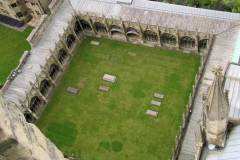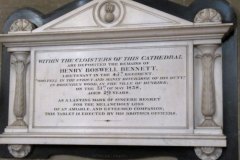In 1838, 29 year old Lieutenant Henry Bennett, of Irish parentage, was serving with the 45th Regiment of Foot (Sherwood Foresters) in Canterbury. He led a unit called to deal with the last armed insurrection on English soil – that of the Cornishman John Nichols Thom, also known as ‘Mad Thom’ or as he preferred ‘Sir William Courtenay, Knight of Malta and King of Jerusalem’. Thom, who had suffered from serious long term mental instability, was leading the revolt of a small band of local rural workers. He shot Lieutenant Bennett dead on 31 May in Bossenden Wood (spelt with one ‘s’ on the memorial stone) near Hernhill, and was duly shot dead himself by soldiers. Bennett thus became the first officer to die in the service of Queen Victoria. On 2 June 1838 he was buried with full military honours in the cloisters – the event attracted six thousand spectators. Given the special circumstances, the Cathedral authorities waived the normal ban on firing of guns in the precincts and permitted the firing of three volleys over Bennett’s grave. One writer has described Bennett as ‘young, inexperienced, impetuous, and thirsting for martial glory and promotion’ (Rogers (1962). Had he withdrawn for just a few minutes to wait for colleagues to arrive in support, Thom might have seen the hopelessness of his situation and surrendered. Thom’s surviving followers were captured and received a range of sentences: two to death but reprieved to be transported for life; one transported for 10 years; and six to prison for one year with one month in solitary. Bennett’s father, Major Bennett, with 39 years’ service, applied for, and was granted, a small increase in his pension to help him bear his loss.
What to see:
- the marble memorial with pediment in the north aisle of the nave erected by his fellow officers
- the image of a flaring grenade above the memorial text – indicating that Lieutenant Bennett belonged to a grenadier company
- reference to his burial in the cloisters – where there appears to be no surviving marker for his grave
Sources; see standard cathedral sources; also Rogers (1962); Kentish Gazette 21 August 1838 p.2
DL


